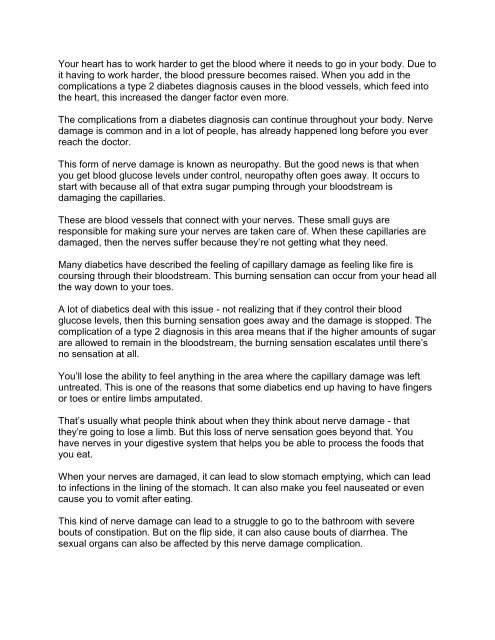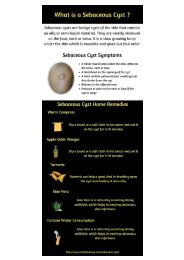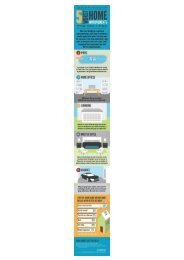How to reverse type 2 Diabetes
http://e4fcewgbvyd29z3ip1w8wdhz4f.hop.clickbank.net/ How to reverse type 2 Diabetes by Eleanor Williams
http://e4fcewgbvyd29z3ip1w8wdhz4f.hop.clickbank.net/
How to reverse type 2 Diabetes by Eleanor Williams
Create successful ePaper yourself
Turn your PDF publications into a flip-book with our unique Google optimized e-Paper software.
Your heart has <strong>to</strong> work harder <strong>to</strong> get the blood where it needs <strong>to</strong> go in your body. Due <strong>to</strong><br />
it having <strong>to</strong> work harder, the blood pressure becomes raised. When you add in the<br />
complications a <strong>type</strong> 2 diabetes diagnosis causes in the blood vessels, which feed in<strong>to</strong><br />
the heart, this increased the danger fac<strong>to</strong>r even more.<br />
The complications from a diabetes diagnosis can continue throughout your body. Nerve<br />
damage is common and in a lot of people, has already happened long before you ever<br />
reach the doc<strong>to</strong>r.<br />
This form of nerve damage is known as neuropathy. But the good news is that when<br />
you get blood glucose levels under control, neuropathy often goes away. It occurs <strong>to</strong><br />
start with because all of that extra sugar pumping through your bloodstream is<br />
damaging the capillaries.<br />
These are blood vessels that connect with your nerves. These small guys are<br />
responsible for making sure your nerves are taken care of. When these capillaries are<br />
damaged, then the nerves suffer because they’re not getting what they need.<br />
Many diabetics have described the feeling of capillary damage as feeling like fire is<br />
coursing through their bloodstream. This burning sensation can occur from your head all<br />
the way down <strong>to</strong> your <strong>to</strong>es.<br />
A lot of diabetics deal with this issue - not realizing that if they control their blood<br />
glucose levels, then this burning sensation goes away and the damage is s<strong>to</strong>pped. The<br />
complication of a <strong>type</strong> 2 diagnosis in this area means that if the higher amounts of sugar<br />
are allowed <strong>to</strong> remain in the bloodstream, the burning sensation escalates until there’s<br />
no sensation at all.<br />
You’ll lose the ability <strong>to</strong> feel anything in the area where the capillary damage was left<br />
untreated. This is one of the reasons that some diabetics end up having <strong>to</strong> have fingers<br />
or <strong>to</strong>es or entire limbs amputated.<br />
That’s usually what people think about when they think about nerve damage - that<br />
they’re going <strong>to</strong> lose a limb. But this loss of nerve sensation goes beyond that. You<br />
have nerves in your digestive system that helps you be able <strong>to</strong> process the foods that<br />
you eat.<br />
When your nerves are damaged, it can lead <strong>to</strong> slow s<strong>to</strong>mach emptying, which can lead<br />
<strong>to</strong> infections in the lining of the s<strong>to</strong>mach. It can also make you feel nauseated or even<br />
cause you <strong>to</strong> vomit after eating.<br />
This kind of nerve damage can lead <strong>to</strong> a struggle <strong>to</strong> go <strong>to</strong> the bathroom with severe<br />
bouts of constipation. But on the flip side, it can also cause bouts of diarrhea. The<br />
sexual organs can also be affected by this nerve damage complication.









